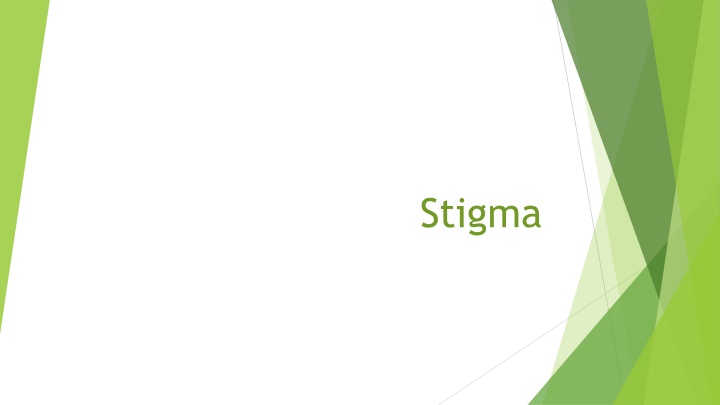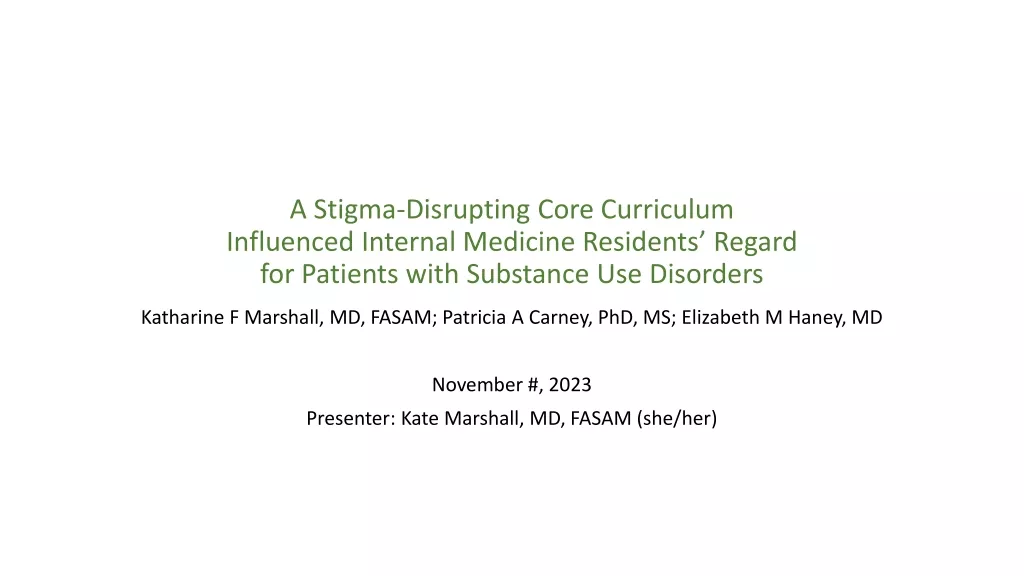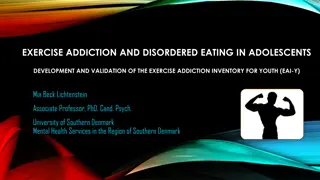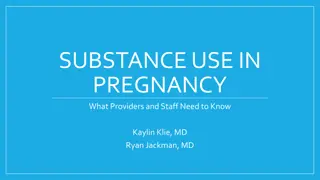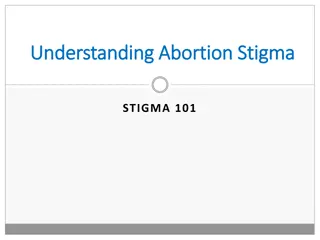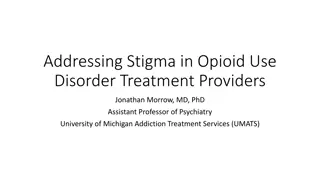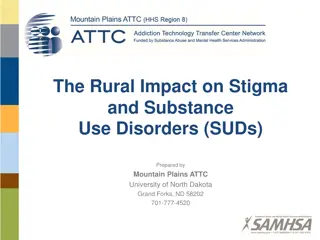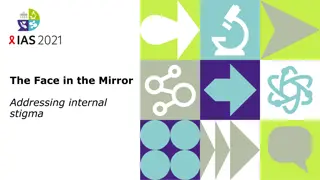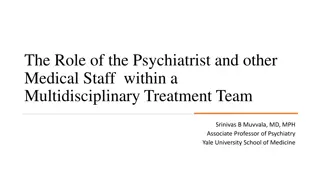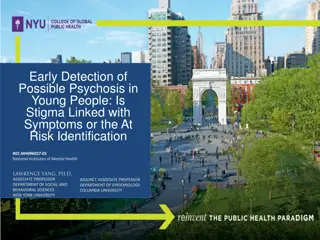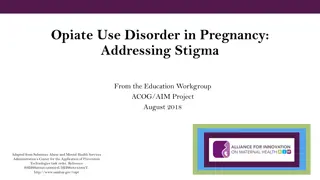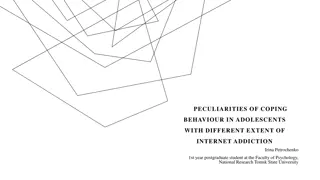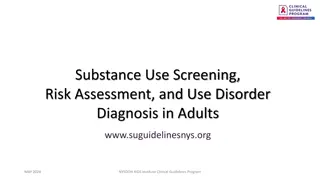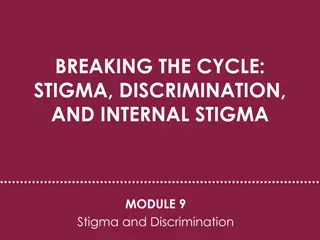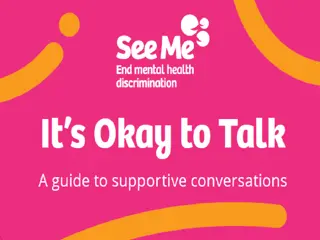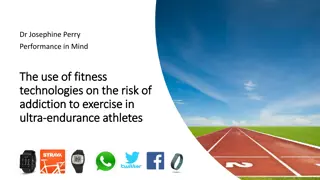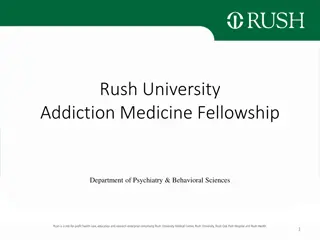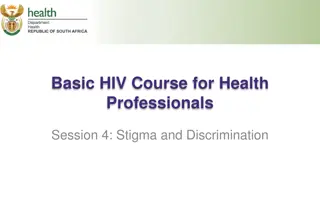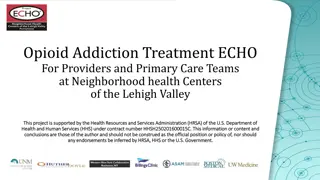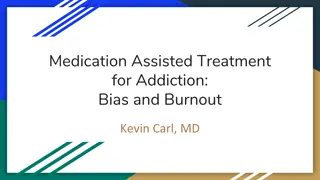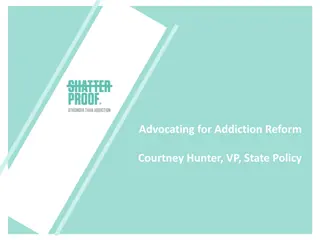Challenging Stigma: Insights on Substance Use and Addiction
Explore perspectives on stigma and treatment approaches for substance use disorders and addiction. Reflect on survey data and encounters revealing varying attitudes towards individuals affected by addiction. Navigate through conversations touching on tough love, faith, and professional counseling as means to address addiction.
Download Presentation

Please find below an Image/Link to download the presentation.
The content on the website is provided AS IS for your information and personal use only. It may not be sold, licensed, or shared on other websites without obtaining consent from the author.If you encounter any issues during the download, it is possible that the publisher has removed the file from their server.
You are allowed to download the files provided on this website for personal or commercial use, subject to the condition that they are used lawfully. All files are the property of their respective owners.
The content on the website is provided AS IS for your information and personal use only. It may not be sold, licensed, or shared on other websites without obtaining consent from the author.
E N D
Presentation Transcript
Stigma A set of negative beliefs that a group or society holds about a topic or group of people (WHO, 2016).
Barry Survey Percent of People Surveyed Indicated they 62% Would work with someone with a mental illness. 22% Would work with someone with Substance Use Disorder. 64% Believed employers should be able to deny employment to people affected by addiction. 25% Believed employers should be able to deny employment to those affected by a mental illness. 43% Opposed giving individuals with substance use disorders the same health insurance benefits granted to otherwise healthy individuals. 21% Opposed giving those with mental illness the same health insurance benefits given to otherwise healthy individuals (Barry, Mcginty, Pescosolido, & Goldman, 2014).
Language Old language Newer language Drunkard Sobriety Inhibit Clean time Alcoholism Deceleration of use Junkie Person in recovery Chemical Dependency Substance Use Disorder
Consider This Imagine a mother attempting to understand the reason her son continues to use substances despite his many promises and attempts to quit may have multiple conversations or read several articles online about this situation. Imagine the confusion this mom might feel when hearing conflicting language and suggestions.
Neighbor to mom: I know what you mean. My great uncle was hooked on crack in 1994. He had to really hit bottom. I mean, we had to pull the rug out from under him. The whole family kicked him to the curb and told him we wouldn t let him come over, give him money, or even talk to him if he didn t get some help. That is what you have to do when someone is a drug addict. He ended up being homeless for a while and going to prison before he knew how serious it was. That is hard but it had to be done. Tough love is what you have to practice on addicts. Best friend to mom: That boy just needs Jesus. He doesn t even go to church with you anymore. He is out running around and making bad decisions. No doctor can cure him. Only Jesus can do that. You keep praying and your prayers will be answered. You know, I read once that God hears the prayers of mothers over all others. You keep praying and you keep telling him how much God wants him to stop. Jesus is what you have to do to get him to stop acting up.
Treatment center counselor to mom: Chemical dependency is a disease. Your son needs treatment for his chemical dependency just like a person with diabetes needs treatment. My treatment center has a 90-day program that will help him change his life. Your son has a chronic condition. His willpower alone is not enough to stop his use. Your support will be important to him while he is in treatment. Treatment is what he needs. Person in 12-step recovery to mom: I know what he is going through. I put my mom through the same thing when I was out there. Tell him to get to a meeting. That is the first thing. Once he gets there, he needs to get a sponsor and work the steps. He has to stay away from the people, places, and things that keep him sick. The steps are what he needs.
Blog found on the internet: There is no evidence that addiction is a disease. People can change if they want it bad enough. People that believe this are just being victims. They don t need treatment. They don t need 12-steps. They need to change their behavior. Education and analyzing behavior can help him with that. Addiction cannot be treated but behavior can be changed. All of these scenarios are based on actual conversations. Everyone has a different experience with addiction and recovery; therefore, everyone has a different idea of the best course of action to change. There is truth in all of these scenarios. There is definitely truth to the person sharing their advice. I am sure you can now envision how these conflicting pieces of guidance might confuse the person seeking solutions.
Contributions from The Recovery Movement People in recovery, from all walks of life, begin uniting to advocate. Training is offered to teach members of anonymous groups how to share about their personal recovery without violating anonymity. The Association of Recovery Schools is formed. Recovery High Schools and Collegiate Recovery Programs are being created. Recovery Rallies spring up across the country. Recovery oriented media grows. Peer Recovery Coaching aids people in early recovery. A bi-partisan, equity act is signed into law to protect people seeking treatment from being discriminated against. The White House Office of National Drug Control Policy creates a Recovery Branch. Young people begin finding their voice in recovery advocacy. Documentaries about recovery are premiered throughout the United States, including: The Anonymous People film webpage and Generation Found film webpage.
Recovery Month Annually, Texas has held The Big Texas Rally for Recovery since 2011. The Big Texas Rally for Recovery took place in Austin, Texas at the state capitol from 2011 2014. The rally now moves from city to city each year. 2011 Austin 2012 Austin 2013 Austin 2014 - Austin 2015 Downtown Houston 2016 - Dallas 2017 - Galveston 2018 - San Antonio 2019 - DFW
Terminology Addictionary
Say This.Not This Say This Not This People with disabilities The handicapped, the disabled Person who has Down Syndrome Downs person, mongoloid Person with a physical disability A cripple Person diagnosed with a mental health condition Crazy, insane, psycho, mentally ill, emotionally disturbed demented Person diagnosed with a cognitive disability or with an intellectual disability Mentally retarded, retarded, slow, idiot, moron
Addiction Related Say This Not This Person with Substance Use Disorder Addict, Alcoholic, Druggie Person with Bi-Polar Disorder She or he is Bi-Polar Person in Recovery
Say Instead of Recovery Protection Relapse Prevention Recurrence of Use Relapse Substance Use Disorder Substance Abuse Substance Use Disorder Chemical Dependency Alcohol Use Disorder Alcoholism/Alcoholic Cocaine Use Disorder Addict Complete Suicide Commit Suicide Attempted to die by Suicide Unsuccessful Suicide Attempt My husband has Borderline Personality Disorder My husband is so borderline Neuro-typical People without diagnosis Person with Opiate Use Disorder Junkie Abstinent of substances Clean Using substances Dirty Survivor Victim
Also Consider. The weather is being bi-polar. That woman is so narcissistic. She is always taking selfies. I love a clean house. I am totally OCD.
How about you? (1) Are you using person first language? Person first language (for example, reference to a person with substance use disorder ) suggests that the person has a problem that can be addressed. By contrast, calling someone a drug abuser implies that the person is the problem.
How about you? (2) Are you conflating substance use and Substance Use Disorder? While some substance use may be illegal or unhealthy, we should limit language about substance use disorders exclusively to situations where a clinical diagnosis has been made. For prevention practitioners, keeping this distinction clear is key to avoid perpetuating stigmas associated with substance use. For example, a person who has used heroin should not be targeted in the language of a prevention effort aimed at people who meet the clinical definition of opioid addiction or dependence.
How about you? (3) Are you using technical language with a single, clear meaning instead of colloquialisms or words with inconsistent definitions? Consider the difference between the terms negative urine drug screen and clean urine. The first is a clear description of test results; the second a value-laden term that implies drug use creates dirty urine. Similarly, pharmacotherapy for opioid use disorder is a technical term for medications that can be used to treat an illness, while substitution/replacement treatment falsely implies that one opioid is being substituted for another, perpetuating the stigma of once an addict, always an addict.
How about you? (4) Are you using sensational or fear-based language? Prevention practitioners often walk a fine line between wanting to inspire action and inadvertently inflating the burden of illness and associated consequences due to a health issue. Referring to emerging drug threats as newer, bigger, scarier, or unlike anything ever seen before can be perceived as inauthentic by people who use those substances. It further compounds stigma by conveying the message that anyone who uses such a terrible substance is stupid, dangerous, or illogical.
How about you? (5) Are you unintentionally perpetuating drug-related moral panic? From publicizing stories about crack babies in the 1980s to opioid babies today, the tendency toward moral panic has a long history in prevention messaging and media coverage of substance use disorders. Moral panics inevitably marginalize people who are vulnerable and often bring their morality or even humanity into question. This moral panic may prevent mothers who use drugs from accessing prenatal care because they are afraid of being judged or mistreated by medical professionals, or of being forced into the child welfare system.
Activity Review Page 4 of the SAMHSA CAPT (Center for the Application of Prevention Technologies) paper for tips for avoiding the use of stigmatizing language.
References Ashford, R. D., Brown, A. M., & Curtis, B. (2018). The Language of Substance Use and Recovery: Novel Use of the Go/No Go Association Task to Measure Implicit Bias. Health Communication, 1-7. doi:10.1080/10410236.2018.1481709. Barry, C. L., Mcginty, E. E., Pescosolido, B. A., & Goldman, H. H. (2014). Stigma, Discrimination, Treatment Effectiveness, and Policy: Public Views About Drug Addiction and Mental Illness. Psychiatric Services, 65(10), 1269-1272. doi:10.1176/appi.ps.201400140. SAMHSA's CAPT. (2017, November). Words Matter: How Language Choice Can Reduce Stigma. Retrieved September 05, 2018. The Arc | For People with Intellectual and Developmental Disabilities. (n.d.). Retrieved from https://www.thearc.org/
